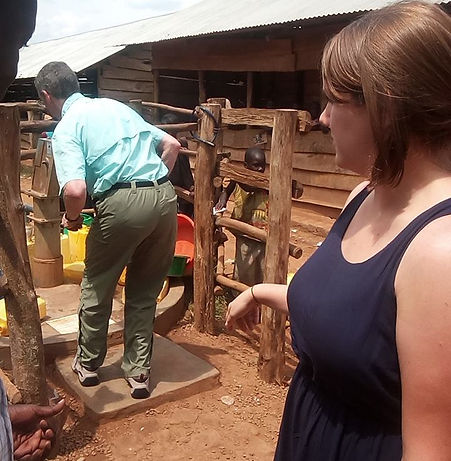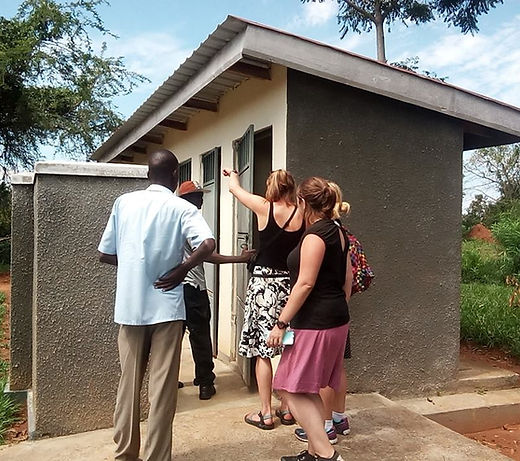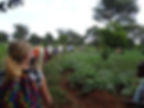
Contact Us Here


Our Basic Programmes/Projects
1.Water Projects.
Water Interventions.
Providing people with clean water looks different in each community. Population, water sources, and terrain all play a part in deciding what technology is needed to best serve people and there is a solution to everything. We currently install 4 different types of water sources.
1.HAND DUG WELLS(
2.DRILLED WELLS (
3.SPRING PROTECTION (
4.water catchment system(
Community Participation.
Our team on the ground select communities to work with based on needs assessments. Communities then decide through group consensus where to locate their water source, elect their own Water Users Committee and are required to contribute in-kind and financially towards the cost of any projects and its ongoing maintenance. This ensures that they feel a sense of ownership toward the pump or latrines &, through the elected & trained Water Users Committee, are more likely to maintain it.
i).Sanitation interventions.
Over the course of the last decade, Busoga Trust has developed an increasingly integrated approach coming to see sanitation and hygiene equal to, if not more important than the provision of water itself. We now never construct a village water source until the sanitation coverage reaches as close to 100% as possible. Our sanitation work takes three main forms.
Community Led Total Sanitation
Our teams in the field implement Community Led Total Sanitation instead. CLTS, as it is known, works on the principle that communities should be shown, without a forced agenda, the extent of their open defecation and the ramifications of this. Shock tactics are used to engender a sense of disgust among villagers. These include communities mapping out common open defecation sites and placing a bowl of rice beside a pile of feces collected from the environs so people can then see the flies moving between the two quite readily. This process is known as “triggering” and results in a community led demand to achieve total sanitation, hence the name. It has reaped dramatic results in our programmes including increased levels of sanitation, over time, from 25% to 90%.
School Sanitation.
In all our programme areas we have embraced the idea of promoting sanitation in schools. As well as providing water sources at schools, we also provide latrine blocks for girls and boys. It is important that girls have separate facilities in which to administer to personal hygiene during menstruation free from the stigmatisation of others. Otherwise girls often drop out of school when they hit puberty.
ii)Promoting hygiene
Good hygiene practices have the potential to reduce the disease burden significantly. Our work on hygiene and environmental sanitation has four main areas of focus.
Home Improvement Campaign (HIC)
HICs are a comprehensive hygiene and sanitation intervention designed to bring a community as close to optimum levels of hygiene and sanitation as possible. First, as ever, a detailed pre-intervention baseline survey is conducted in order to establish coverage levels across the village. Then a home is chosen to be a demonstration case, or “model home”. This will be used to train the wider community in both the need for, and construction methods of, a wide range of beneficial assets including; Fuel efficient cook-stoves, Refuse pits, Soak pits (to pour away grey water), Ventilated Improved Pit Latrines, Separate, private bathing areas, Animal pens, Washing lines, Drying rack (for pots, pans, etc), and Mosquito repellent plants.
This training is provided over a three month period, supported by relevant topics on the weekly WASH radio show. At the end of the period, a post-intervention survey is conducted and all the households are ranked relative to the level of their sanitation. A prize giving ceremony is held, attended by local dignitaries and representatives of neighboring communities, where prizes such as mosquito nets, soap and basins are distributed. Distribution of nets and soap is a health intervention in itself, but adding extra prizes such as paraffin lamps helps make it a genuine reward for relative effort.
Tippy Tap hand washing facilities.
We train communities in how to construct Tippy Tap hand washing facilities from locally available materials. Hand washing saves lives – washing hands after using the toilet or before handling food, for example, is an easy and affordable intervention that can reduce diarrhea among children under five by almost 50 per cent, and cut respiratory infections by as much as 25 per cent.
2.Health Care programmes/HIV/AIDS.
BUVOCOD implements health care projects aligned to the national needs within the health sector. It aims at improving people’s health welfare and contributes to the health sector’s interventions in promoting a healthy and economically productive society. BUVOCOD intendeds to supplement the work of the Ministry of Health as regards to the reduction on the Maternal, Infant and Child mortality rates and improvement in the Maternal & Child Health in Uganda hence contributing to the fourth and fifth Millennium Development Goals of reduction in Child mortality rates by two thirds by 2020, reduction of maternal deaths by three quarters by the year 2020.
HIV/AIDS Services In the rural communities.
we create awareness,prevention,Testing and counselling to mostly people in the rural communities in Busoga region.
3.Education And Services for Children Programmes
Busoga volunteer for community development is committed to saving vulnerable children from disease, malnutrition, exploitation, illiteracy, and despair. Our multi-faceted approach impacts the lives of children and families through health care and education–two of the most critical factors in reducing poverty and Illiteracy in the Busoga sub Region and Uganda.
In Uganda, one of the world’s poorest countries and land locked in the East Africa, families struggle for sustenance, health, and education. They struggle to survive. Busoga volunteers’ programs lift families up out of poverty and the struggle, resulting in a direct impact on nearly 10,000 people each year.
We are also concerned about child labor and trafficking in Uganda. We support from our kind Donors and partners we support children from dangerous, abusive, and neglectful situations. Children receive nutritious meals, health care, and educational sponsorship to go to school and professional trauma and behavioral health treatment.
Among Other services in this area Include:
-
Access to Primary and Secondary School sponsorship, Functional Adult Learning including components from food security, health and economic development portfolios.
-
Schools rehabilitation and construction
-
Schools managers/administrators training
-
Curriculum development and management training
-
Vocational training etc.
.
4.Promotion of Human Rights and Good Governance
The policy and advocacy department of BUVOCOD seeks to empower communities to positively influence national policies and practices towards improvement of their living conditions. It considers community empowerment to be community ownership, management and control of their life choices. By harnessing communities with skills to monitor and evaluate their development, they become capable of monitoring the development process on their own. This ability and the motivations that it engenders enables them to independently sustain their development outcomes
formulated the strategic indicators for the lobbying and advocacy department as follows:
1. To create awareness on issues of policy rights and entitlements of water, hygiene and sanitation, food security and health.
2. To enhance the capacity of communities to engage in policy processes on pertinent issues affecting agriculture, conflict resolution and peace building, health promotion, human rights awareness, water sanitation and hygiene, gender issues and any disasters that may come up
5.Sustainable Agriculture:
BUVOCOD’s agriculture programs in the Busoga region in Uganda cover the districts of Mayuge,Buyende,Iganga,Namutumba,Kamuli,Luuka and Bugiri where a total of 8,480 farmers are reached, organized into 216 groups and formed into 26 associations.
The strategic objectives for the agricultural programs of BUVOCOD can be expressed as below:
-
To improve the knowledge and skills of CID farmers in integrated crop, livestock and agro forestry farming.
-
To improve the access to production resources among BUVOCOD farmers.
-
To develop and strengthen group marketing among BUVOCOD farmers.
-
To increase collaboration between BUVOCOD, community beneficiary groups and local authorities.










